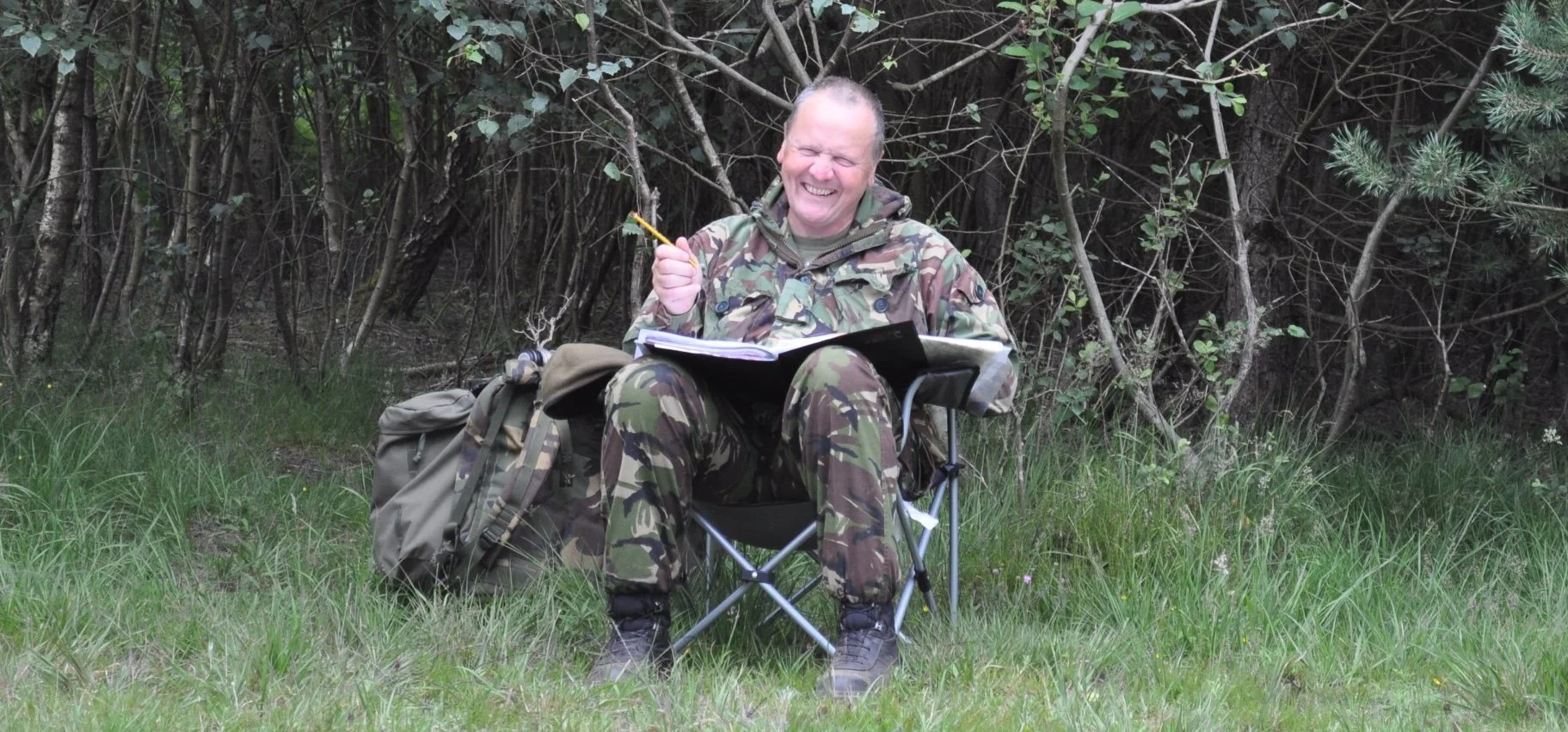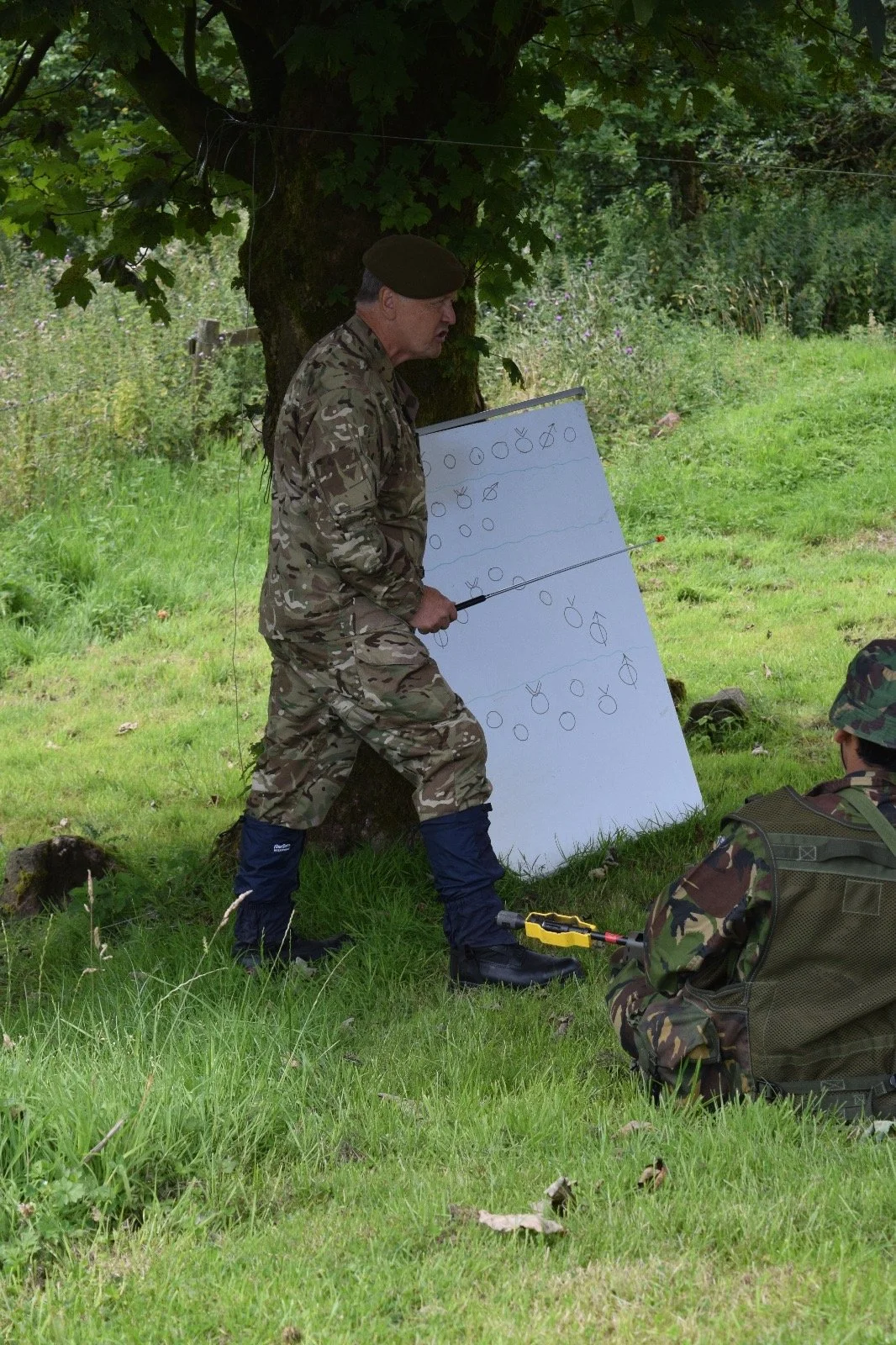Major Roger Edmund Machin (CCF 2012 to ~2019)
Roger Edmund Machin died on 25th September 2025, after a brave battle with dementia. There will be much sadness amongst his family, friends and former TA/AR and colleagues, particularly in the QMGS CCF community of former Cadets and current and former Officers. He was a serving CFAV Officer in the Queen Mary’s School Contingent, attending Friday weekly parades as a mentor to the Senior Army Cadet of the time; his other contributions were at Annual Army Camps, Senior Cadet Instructor Cadres (SCICs) and particularly at Farchynys training weekends when he ran his legendary Cadet Command and Control Trainer (CCCT) exercise.
Roger was a quiet planner, always looking towards his next cadet exercise. He was a calm voice in any situation, born out of his long experience with the Territorial Army (TA) now the Army Reserve. He was witty, insightful, intelligent and always willing to add an informed and well-reasoned piece of advice. Incidents and memorable situations always seemed to revolve around vehicular transport, keys, training areas, communications and Major Machin. Roger was of great help to the fresh-faced Commanding Officer of QMGS in the early days of the running of the Contingent for which he will be eternally grateful.
Roger was born in Walsall and lived in the Delves, well within hearing distance of a loud, goal-scoring roar from his beloved Walsall FC at Fellows Park. Roger was a life long supporter of Walsall FC and was a season ticket holder along with his daughter Jacquelin. He would travel to Swindon to stay with his brother Ian and watch the game between the two teams whenever they were in the same division. He attended Whitehall School and Queen Mary’s Grammar School playing cricket and rugby for the 1st XI and 1st XV. Academically he took French, Economics and History to A-Level and went on to read History at Liverpool University. As soon as he could he joined the School’s CCF and progressed to become the Senior Cadet RSM in his final year. During his time as an undergraduate he was called upon, by the then CO of QMGS CCF, John Dickson, to help out on Summer Camps. Inevitably an incident, which has attained infamous and legendary status, occurred on the Isle of Man during one such Camp. Details have always been vague and it’s probably best that they remain so. The incident occurred on an exercise run by an attached Lieutenant; it involved a Very pistol, a fire engine becoming bogged down in sand, a substantial area of the heathland on the island being burnt to a crisp and Roger. One witness said that if prompt action had been taken by the Lieutenant to attend to the burning bush rather than taking a declaration from the cadets, less vegetation would have been destroyed. The local lighthouse keeper said it provided the most excitement that had occurred for years.
Throughout the following years after graduation with a History degree, Roger worked in the Midland Bank, but finding it too restrictive and unadventurous he became a teacher of History and later moved to teaching Information Technology. Which has always been a source of wonderment to those close to him as his skills with digital resources was never well honed.
Throughout his working life he always maintained his passion for military activities; he joined the Army Reserves – in his day it was the Territorial Army (TA). Roger was commissioned into the Mercian Volunteers, which became reorganised to become 3 STAFFORDS based initially in Intown Row in Walsall, thence to Bath Street. He quickly became promoted to the rank of Major and became Company (Coy) Commander (Cmdr) of D Company, Walsall. Later he became an Army assessor at Westbury in Hampshire and then Coy Cmdr at Birmingham University OTC. Later still became Battalion 2/ic and acting Lieutenant Colonel covering for the CO. Several of his former NCOs from his TA and later AR years have publically stated their gratitude for Roger’s assistance and advice to attain promotion in their detachments.
Having separated from his first wife, Susan, he remarried to Becky who ran a guest house in Tain, NE Scotland. During this time he travelled around Scotland identifying and advising on SEN pupils in schools. He was invited to be a CCF Contingent Commander at a school in Kent in the middle years of the “Naughties”. He was persuaded to, by the new Contingent Commander of QMGS CCF, resign his post in Kent, which took him away from home and to transfer his commission to QMGS CCF. The decision to carry this out was a good one, as it allowed Roger, not only to visit his mother in Walsall on a regular basis, but also to spend time with the grandchildren who lived in the Walsall area. He would babysit and later take Samuel to the Arboretum and then later look after or visit Isaac and Jude. He was immensely proud of the grandchildren, especially when Sam was chosen to walk out with the players at a Walsall home game.
Friday parades at QMGS saw Roger travel up from Worcester where he lived with his partner Paula, visit his mother or grandchildren and then attend Parade in the afternoon. It was in the years between 2012 and 2018 that Roger’s contribution to activities with QMGS were most effective. His TripleC T weekend at Farchynys became a cult WE for the cadets. Many of them going on their first as a junior model shifter to becoming a strategist, radio operator or planner in the 5th weekend’s attendance. After dinner on Friday, the posts and positions would be appointed, SIPs would be held on various types of weaponry, and expectation started to build. On Saturday the day would be spent recceing the battlefield at various points on Morfa Harlech. Defensive positions, weakness points and attack areas would be discussed. Saturday evening would be spent on more SIPs and the various groups would gather to discuss plans and strategies to repel the Red Forces of General Bolivar’s military might. Whilst out, the lines of communication would be set up between the Cader Room and Day Room.
By Sunday the battlefield and campaign groups would assemble in the rooms. One metre map tiles would be laid on the Cader Floor and defensive forces (models) laid out. As H Hour approached the nervous Cader Room staff would fall silent, with serious looks of anticipation and expectation. Once Roger “fired” the first shot at 09.30 the “Battle” would ensue and rage for 3 hours or so. The cadets would be completely absorbed in their tasks. Tactical decisions in response to attacks and advances would be relayed by “comms” to the strategy group “in the field” in the Day Room. They didn’t always get it right. By the end, the cadets’ energy spent, clear up would take place in an atmosphere of some confusion as to who had won or was winning. A debrief and lunch were undertaken, all cadets resolving to return the next year. There is, sadly, no one who goes today that will remember the Machin led forces, but happily Sqn Ldr Ridler still takes the WE and it’s as popular as ever.
At CCF Camps and SCICs his cadet exercises were legendary, always spread over huge areas of real estate, involving patrolling, ambushes, section and platoon attacks, TEWCS. He would be constantly writing orders to deliver to HQ, platoon and section commanders, always with an eye towards full cadet involvement and enjoyment. He succeeded immeasurably. An amusing event took place when the Commanding Officers was being roasted by the Camp Commandant for an incident, for which, in fact, the CO was not responsible, but the previous Unit, that had been in the Camp. Half way through the “hairdryer” session, outside of the CC’s office window, Roger walked past with a long plank on his shoulder supported at the other end by a much shorter cadet. On another day that may have seemed quite normal. It was a feat of great self-control on the part of the CO that he didn’t burst out laughing.
Typically Roger had an amazingly full library of military campaign books, books on Military leaders and the like. His knowledge of the D-Day Landings was first rate. He had a model made by the DT students on which he could display the sand collected from the beaches, their relative positions and brief details of the forces involved on each beach.
His battle with dementia became increasingly difficult for him; by 2021 he could no longer drive, either to QMGS or to watch Walsall home games at the Bescot Stadium. Roger became increasingly forgetful and anxious and eventually had to move away from Worcester and Paula to be nearer to his daughter Jacquelin, who took on great responsibility for his care at Manor House Nursing Home. His family were very caring and supportive right to the end.
Twice married, firstly to Susan(dissolved 2001), with whom he had two children, Jacquelin and Peter, secondly to Becky(divorced) and latterly lived with his partner Paula.
Roger Machin was born 17 April 1956, died 25 September 2025




